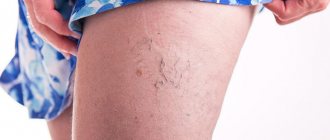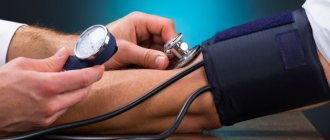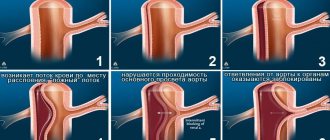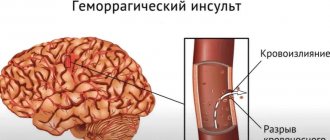01.05.2017
Last modified: February 7, 2021 at 07:08 pm
To treat illnesses, the doctor prescribes massage therapy. But the effect of massage is not always positive. There are some restrictions, for example, when blood pressure increases after a massage.
The root cause is a problem with the vascular system, so massage treatments are not prescribed for hypertensive patients. And despite its usefulness, if after therapy you feel a headache or lose orientation in space due to dizziness, then you should refuse this type of treatment.
What causes blood pressure to rise after a massage?
Why does blood pressure rise after a massage? To understand the root cause, you need to know how it affects the body, the vascular system. And also how incorrect technique negatively affects a person’s general condition.
The procedure itself has a positive effect on well-being, because processes in the body improve:
- The body's work is stimulated;
- Vessels dilate, which improves blood flow;
- Internal organs are supplied with a large amount of essential nutrients and oxygen;
- The heart begins to work hard;
- Metabolic processes are accelerated.
But the patient does not always feel good after the session. Many people complain that after a massage their blood pressure rises, accompanied by several symptoms.
The main cause of such problems is hypertension. Therefore, among the contraindications to the procedures are:
- Age restrictions, because the older a person is, the greater the likelihood of having problems with the heart and blood vessels;
- The patient’s condition and poor health also cause a negative reaction from the body;
- The presence of diseases with the vascular system such as hypertension.
One of the reasons for increased pressure is incorrect specialist technique. Even an experienced massage therapist can make a mistake that will lead to a worsening of the condition. Dizziness and pain in the neck and head occur.
Due to increased blood circulation, body temperature also rises. Which also causes dizziness, because human tissues are saturated with oxygen in an enhanced mode, which is a kind of stress for some body systems.
A layman increases pressure on the spine, which provokes the release of harmful chemicals into the patient’s blood. Such internal poisoning is often accompanied by:
- Headaches;
- Loss of orientation;
- Nausea and even vomiting.
After such manipulations, the pressure rises and the condition worsens.
Blood pressure in osteochodrosis
According to WHO statistics, degenerative pathologies of the spine in people over 50 years of age occur in 70-90% of cases.
The results of epidemiological studies show that back pain is in second place (after acute respiratory infections) among the reasons for visiting specialists. Approximately 50% of the adult population suffers from pain syndrome of vertebrogenic etiology, the cause of which is the degenerative-dystrophic processes occurring during osteochondrosis, accompanied by manifestations of a neurological nature.
When localized in the cervical region, osteochondrosis often leads to increased blood pressure.
The problem of high blood pressure occurs at almost any age. Blood pressure may increase due to:
- psychological state of a person;
- time of day;
- taking various stimulants (for example, coffee, tea);
- presence of stress factors;
- a number of diseases;
- bad habits;
- excess weight;
- metabolic disorders;
- poor circulation;
- sedentary lifestyle;
- the presence of a hereditary predisposition.
Many of these factors simultaneously contribute to the development of osteochondrosis. For example, metabolic disorders in the cervical region or prolonged stay in a stationary position often provoke degenerative changes in the vertebrae and intervertebral discs, which in turn lead to the development of cervical osteochondrosis, accompanied by symptoms such as high blood pressure. It turns out to be a kind of vicious circle: the same factors contribute to an increase in pressure and the development of osteochondrosis in the cervical region, and degenerative-dystrophic damage to the discs and vertebrae provokes an increase in pressure.
Hypertension as the main cause of high blood pressure
Hypertension is a common disease found in middle-aged and older people. The cause is:
- Age;
- Heredity;
- Inactive lifestyle, such as sedentary work;
- Having a lot of weight;
- Bad habits such as alcohol or smoking.
Important information: How to lower blood pressure: three herbal medicine recipes
In the presence of such a disease, massage is prescribed extremely carefully and only after preliminary treatment. Nervous tension and constant stress have a negative impact on your general condition. If your blood pressure rises after a massage prescribed by your doctor, you should interrupt the course of therapy and undergo additional examination and treatment.
Methods for treating hypertension
In addition to traditional methods of treating hypertension, massage techniques are also prescribed. But they should be carried out extremely carefully and only by professionals.
When the procedure is carried out correctly, the patient’s condition improves significantly, relaxation helps to normalize the functioning of the nervous system, and therefore the cardiovascular system. Breathing normalizes and high blood pressure returns to normal.
Often the doctor advises you to massage yourself; there are techniques that will help normalize the body’s functioning without causing harm.
Indications for the procedure
With persistent high blood pressure, massage procedures are recommended only at the initial stage of development of the disease. That is, when hypertension is diagnosed:
- Stage 1, in this case the pressure rises periodically and no violations of the internal organs are observed.
- Stage 2, with a persistent increase in pressure, but with a constant change in its level, that is, a person experiences crises, surges and declines in indicators.
At the third stage of the disease, that is, after diagnosis of arterial hypertension, characterized by severe atherosclerosis and the development of pathologies of internal organs, this physiotherapeutic procedure is contraindicated. In addition, the stages of severity of arterial hypertension are divided into different phases:
- Phase “A”, when working capacity is maintained or slightly reduced.
- Phase “B”, when it is necessary to take measures aimed at normalizing blood pressure in order to maintain performance. In addition, the risk of heart attack or stroke increases significantly during this phase.
Thus, after a person is diagnosed with stage 1 or 2 hypertension in a stable “A” phase, the doctor will definitely recommend a massage. This will allow:
- Reduce the excitability of the nerves and muscles of the vascular wall, and, as a result, lower blood pressure.
- Reduce blood stagnation in the veins.
- Increase the body's resistance to negative environmental factors.
Acupressure is a component of complex treatment of hypertension
For quite a long time, acupressure for hypertension was considered only a way to relieve dangerous symptoms of high blood pressure. But currently it is carried out at specially selected reflex points, the rhythmic impact on which allows the use of mechanisms that help maintain the elasticity of blood vessels.
That is why acupressure has recently been increasingly included in the complex of therapeutic measures for hypertension at the initial stage. Acupressure should be done only with the pads of your fingers. In case of hypertension, thus, special points located in the area are affected:
- Necks;
- Epigastric region of the abdomen;
- Forearms;
Left foot.
The procedure can be carried out independently at home, but only after consultation with a doctor.
It has been proven that systematic procedures at the initial stage of hypertension can stabilize blood pressure for a long time and significantly improve overall health.
Correct massage techniques
If the massage rules are not followed, a person may experience headaches, weakness and dizziness. What contributes to this?
- Poorly chosen massage technique. For each patient, it is selected taking into account his problem and the doctor’s advice.
- If the procedure is performed by a non-professional.
- Inconvenient massage table or incorrect head position during back and neck massage.
- Strong pressure on the vertebral arteries.
- Deformation of the arterial canal in the spinal zone.
Massage of the cervical spine must be carried out correctly, because in this place there are important arteries that supply the brain with blood and oxygen. If the wrong technique is chosen, this leads to severe compression of the canal and, as a result, headaches.
If a patient is diagnosed with hypertension, then the classic method of massage or acupressure is most often prescribed.
Attention: When choosing a specialist, you should take into account his professionalism, because your health primarily depends on his qualifications.
The massage should last about 20 minutes. People with problems with the vascular system are prescribed a course of massage, the positive effect of which can be felt already in the 6-7th session. Much depends on the severity of the problem and the individual's individual reaction.
Acupressure differs from the classical technique. Doctors prescribe it to patients most often. And the effect of such procedures is felt already in the third session. But if a classic massage requires up to 16 sessions, then acupressure requires about 24 sessions. Massage therapists themselves advise visiting their office twice a day if the patient is prescribed a course of acupressure.
Important information: Withdrawal from binge drinking: stages of the disease and basic methods of therapy
To achieve the effect, the patient must lie on the massage table for at least 10 minutes just like that, this will help him relax, forget about problems, and disconnect from everything for a while.
Before the massage you should not smoke for at least two hours, coffee is also excluded. Because these products stimulate increased blood pressure. If medications are prescribed, they should also be taken before the procedure. To normalize pressure, two groups of points are used:
- The first group of points is stimulated only on odd days.
- The second point group is massaged only on even numbers.
Thanks to this approach, the patient feels improvement much faster. The time period during which you should press on the desired points is from 30 seconds to 1 minute.
The uniqueness of this technique is that you can do it yourself if you know how to do it. The technique of performing acupressure involves vibrating where the desired points are pressed. If the procedure is carried out independently, then regular massaging or stroking is sufficient.
Self-massage
Self-massage is performed if it is not possible to visit a specialist. Convenience lies in the ability to conduct it anywhere and at a time convenient for you. It is best to massage the desired areas in the morning, when the body is in a relaxed state.
Choose a comfortable position so that nothing interferes with the procedure. The most comfortable way to do this is lying on your stomach or standing. Since performing a massage yourself is not as convenient as a specialist, it is worth taking short breaks.
It is necessary to start the massage from the back; in this place there are the main points that require stimulation. The technique used is stroking the areas, followed by frequent rubbing and warming up. Start massaging your back from the lumbar region, gradually moving upward.
Then move on to the buttocks, massage procedures help to gradually get rid of cellulite, which accompanies all hypertensive patients. Relax the leg being massaged, this way the effect will be better.
Start with stroking, then rub your leg vigorously to warm up the muscles. Then proceed to light tapping with fists and finish the procedure with gentle rubbing of the leg.
The next area for self-massage is the abdomen. Massage it clockwise, gradually approaching the navel area.
Massage and self-massage for hypotension
If problems with low blood pressure occur, doctors recommend massaging the lower back and sacrum daily.
You should also pay attention to the buttocks, abdomen and calves. When treating patients in this group, you will first need to place them on their stomach.
After this, you need to massage the lumbosacral region with gentle movements in the lower direction. Then on the lower back you need to perform movements from the edge of the vertebra to the sides. It takes 3-5 minutes to perform such manipulations. At the end, it is recommended to shake the pelvic bones a little, this will eliminate blood stagnation in this area.
After massaging the sacral region, it is important to spend time on the back of the legs. The shins and thighs can be massaged with rubbing movements, patting, chopping
The pace should be moderate at first, but gradually increase. As soon as manipulations with the back of the legs are completed, it is necessary to turn the patient onto his back.
In the same way, you need to massage the front of your legs.
In this case, there is no need to pay special attention to the joints; this will only be useful if the patient has problems with them
The procedure is completed according to all the rules in the abdominal area. It can be ironed in a circle, and the pressure can be softer or stronger. After stroking, you can pinch and rub the skin a little. In this case, it is best to do this with the side surfaces of your palms. Vibrating the abdomen will not hurt; you can do this vertically or horizontally.
Attention! For such a massage to be beneficial, the total duration of the session should be approximately 15-25 minutes. The course of treatment is at least 15 procedures
To consolidate the results obtained from the session, you can perform self-massage. It also implies the exact execution of the algorithm:
- in case of hypotension, only the lower back, legs and abdomen need to be massaged;
- movements can be energetic and smooth, it is useful to alternate the pace of kneading;
- You also need to massage your back first, then move to your legs, and finish with your stomach;
- It is allowed to pat, massage with strokes, pinches, and light pressure;
- You cannot press or rub the spine too hard; all movements and manipulations should go in the direction away from it.
The procedure should not be performed in the presence of cancer, tuberculosis, hypotensive crisis, or serious skin lesions. If it is necessary to perform manipulations on a pregnant woman or children, a preliminary consultation with a doctor is required.
When such procedures are performed regularly, blood flow significantly improves, it becomes more fluid, which protects against thrombosis. Headache, apathy go away, appetite improves.
Attention! Massage requires a clean skin surface, especially when using a lubricant. If the patient is sweaty or neglects personal hygiene, frequent rubbing and rubbing may cause skin problems in the form of irritation and rashes.
Before starting therapy, you need to visit a therapist and cardiologist. He will monitor changes in pressure over time, after which a decision will be made on the possibility of using massage to suppress high or low blood pressure.
When prescribing such manipulations, it is strictly forbidden to refuse medications that were prescribed to relieve attacks of arterial hypertension or hypotension.
You should not use massage during a hypotonic or hypertensive crisis.
Massage and self-massage are only auxiliary procedures that cannot eliminate the very cause of the pathology. If discomfort occurs during the manipulations or the patient’s condition worsens, it is advisable to contact a specialist again to adjust the treatment regimen.










